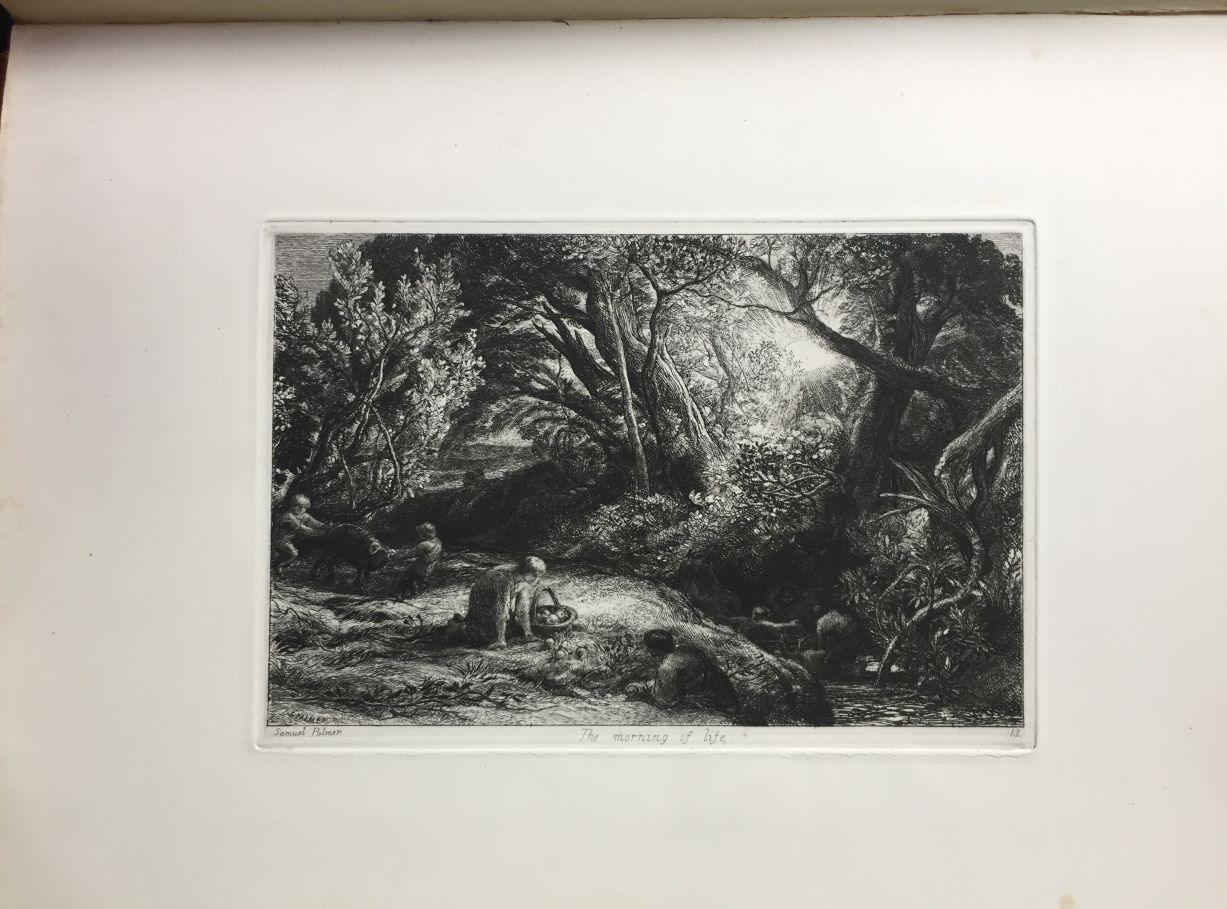![]()
Samuel Palmer. 1805-1881.

The Morning of Life. 1860-61. Etching. Lister 10.vii. 5 1/2 x 8 1/2 (sheet 10 1/4 x 14 3/8). Lister writes, "The plate is lettered as follows in the lower margin: Samuel Palmer. 'The Morning of Life' 13. The outstretched arm of the left-hand sheep-washer has been highlighted by burnishing. The edge of the left-hand bank of the stream has been similarly burnished. The highlights of the foreground are intensified. Published as plate 13 in Etchings for the Art Union of London by the Etching Club, 1872." Edition of 450, printed by Frederick Goulding with retroussage; the only issue. Illustrated: Print Collector's Quarterly 3 (1913): 227. A rich impression on white laid india paper. The edges of the wove support sheet gilt. Signed and titled in the plate.
As issued, with the complete volume: ETCHINGS FOR THE ART-UNION OF LONDON Twenty Plates by THE ETCHING CLUB LONDON: By the Etching Club , MDCCCLXXII, 1872 [published date: 1872 ]. Rare First edition. 4to. 15" x 11" inches (LxB). There are 2 leaves (title leaf and table of contents), + 20 [of 20] leaves of original etched plates . The etchings and drypoint on chine appliqué, laid onto thick album sheets, each sheet c.375 x 265 mm. (14 3/4" x 10 1/2" inches). All edges gilt. Fine original contemporary publisher's gilt pictorial brick red cloth binding, gilt lettering on the spine & on the front cover. All the plates are first printing, 1st issue, all the plates printed on rectos only. All etchings numbered and signed in plate margins. The 'Etching Club' was founded by Charles West Cope in 1838. The artist association that was in existence until 1878, published numerous illustrated works by authors such as Oliver Goldsmith, Shakespeare, John Milton and Thomas Gray. This portfolio, published in 1872, contains 19 (of 20) etchings, signed and numbered in the plate, by the following artists: Thomas Creswick (1811-1869), John Everett Millais (1829-1896), John Callcott Horsley (1817-1903), George B. O'Neill (1828-1917), Charles West Cope (1811-1890), Seymour Haden, Frederick Tayler (1806-1889), Richard Ansdell (1815-1885), James Clarke Hook (1819-1907), Richard Redgrave (1804-1888), Samuel Palmer (1805-1881). $2,750.


![]()
Palmer began this plate as a subject taken from Virgil’s Aeneid, "Hercules & Cacus". When this proved unsatisfactory (I could no-how clip my poodle into lion shape, as Palmer expressed it in a letter to Hamerton in 1872) he altered the figures completely and transformed it into the present Virgilian idyll, with sheep washing and a conversation over apples. He also extended the etched area on all four sides, resulting in his only print with narrow plate borders. Palmer wrote to his printer in 1871 instructing him to erase the title Hercules and Cacus from the plate, the "true title" being A Leafy Dell. Palmer also referred to it as Sheep-washing and Work and Gossip before finally settling on the published version, The Morning of Life.
Not only the theme but the practice gave Palmer great difficulties. The copper plate was supplied by the Etching Club and had already been used for a previous etching and burnished clean for re-use before Palmer himself was burnishing it again to change his composition. A H Palmer in The Life … (page 99) quotes his father on some of the problems as he worked towards the finished image of the “wretched plate [which had] bent up like an earwig disturbed in an egg-plum."
I spent several days working and proving in London in a ghastly frame of mind, owing, for once, not to my own clumsiness, but to the detestability, both as to thinness and quality, of the old, scraped, Club copper on which [my etching] was done. I gave myself up for lost on Saturday at 5.30, but, by a desperate perseverance, had singed the last neck of the hydra by 6.15, and hope to send you soon, one of the very best impressions.
The published edition was the first printed by Goulding, advocate of retroussage, for the Etching Club and Palmer was taken aback by the dramatic printing, very different in effect to the clean-wiped plates of the previous Club printers Gad & Keningale. None the less the following year, 1873, when he acquired his private press, Palmer would engage Goulding to teach his son Herbert to print. Goulding demonstrated retroussage and A H Palmer used the method, which he calls "artistic printing"s for subsequent Palmer proofs.
![]()
![]()
To order, to report broken links or to be placed on the email list, please contact Jane Allinson (jane@allinsongallery.com), call (001) 860 429 2322 or fax (001) 860 429 2825. Business hours are 9:A.M. to 5 P.M. Eastern Standard Time.
Please click here to review the USE AND ACCEPTANCE AND PRIVACY POLICIES FOR THE ALLINSON GALLERY, INC. WEBSITE
Thank you for visiting this website.